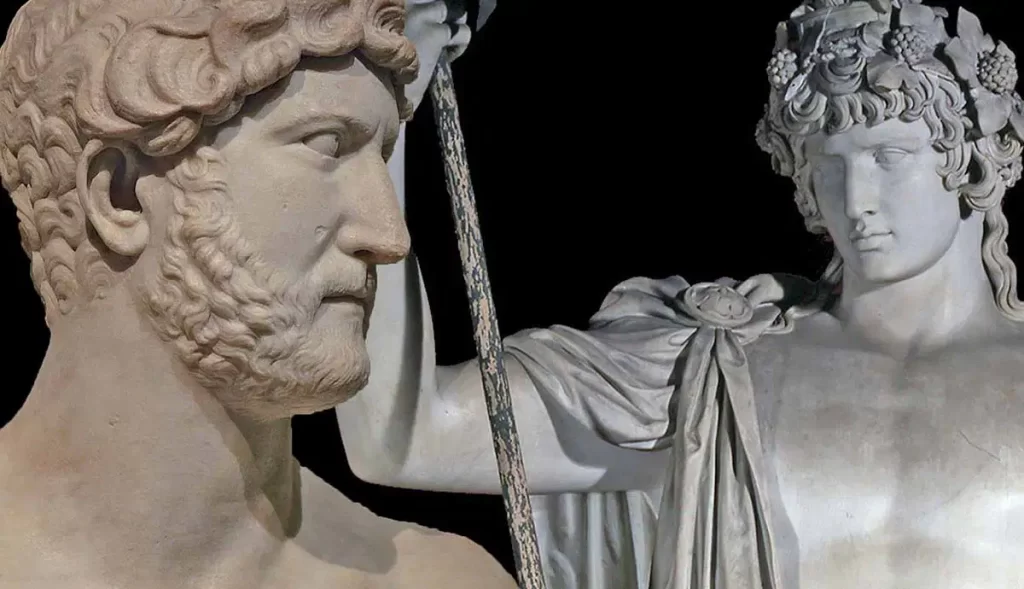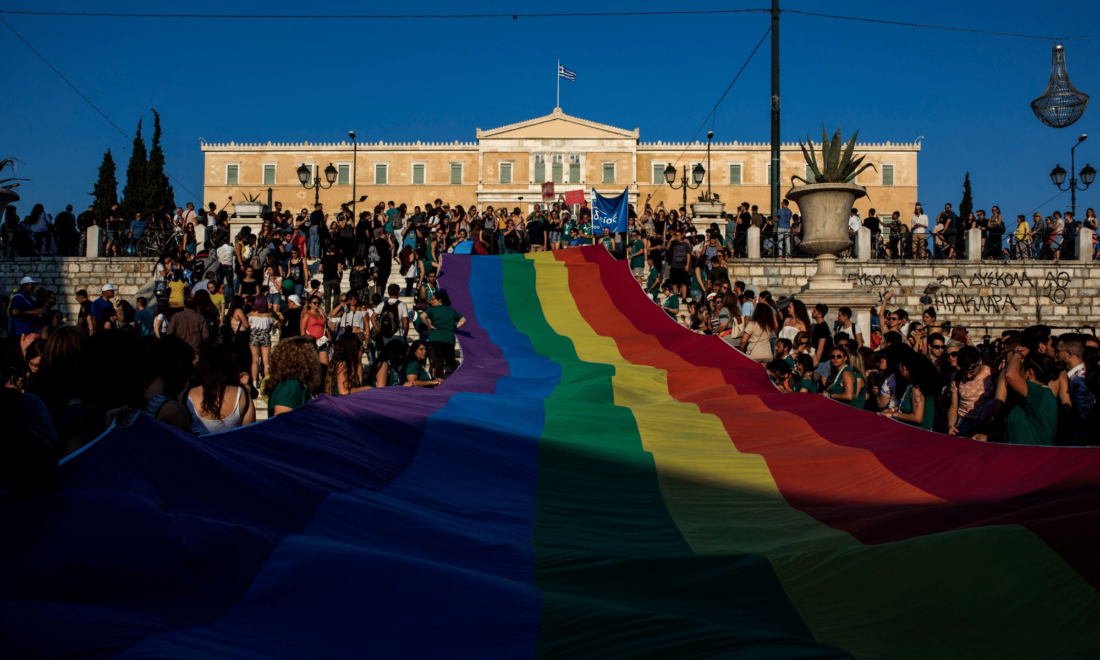In this article about gays in Ancient Rome, we will briefly describe what it was like to be gay. We will also explain how they viewed sexuality and what was allowed and forbidden. Finally, we will introduce you to some famous Gays in Ancient Rome. So stay with us if you want to learn more.

©ShutterStock
You Weren’t Gay or Straight. But Top or Bottom.
Living in ancient Rome was a vastly different experience from today. The Latin language did not have specific words for homosexual or heterosexual. Instead, sexuality was defined by the roles people assumed during sex rather than the gender of their partners. More significantly, Romans did not even have a word for homosexuality. The influence of power and status on sexual relationships was profound. For men, being the submissive partner was equated with weakness, and thus, social class, not gender, determined their partners, shedding light on the societal norms of the time.
Furthermore, the dynamics of same-sex relationships in ancient Rome were complex and intriguing. Men could engage in sexual relations with other men without compromising their masculinity as long as they assumed the dominant role. Acceptable partners included enslaved individuals, prostitutes, or entertainers. While there is less documentation of female same-sex relationships, some evidence suggests they did exist, adding a layer of mystery to the topic.
For freeborn Roman men, it was acceptable to have sexual relationships with both women and men, provided they took the penetrative role. The morality of these acts depended on the partner’s social status, not their gender, reflecting a surprisingly open-minded approach to same-sex relationships. It was considered wrong for a man to have sex with another man’s wife, daughter, underage son, or the man himself. Married men often sought sexual pleasure with those of lower status, including prostitutes and enslaved people. Historical accounts suggest these practices were standard, but individual experiences likely varied, showing a level of acceptance in ancient Roman society.
Interest in same-sex relationships appeared in Latin literature during the 2nd century BC, influenced by Greek culture. In Greece, such relationships were seen positively but could weaken a father’s authority in Rome. Women in Rome played an important role in educating their sons, leading to fewer same-sex friendships than in Classical Athens.
Nero, an important Roman leader, exemplified this mindset by engaging in sexual acts with both men and women. His marriage to a young eunuch named Sporus was controversial because he took the female role. The disapproval came not from same-sex relationships but from breaking gender norms.
While Rome was seemingly sexually open, it was not a society of equality. Women were often treated poorly, and lesbian relationships were considered shameful. Women in such relationships were seen as adopting a man’s role, which was frowned upon by society. Women in Rome lived restricted lives, and those who gained power were exceptional in a male-dominated world.
Note: To learn more about homosexuality in Ancient Greece, we recommend reading our related article.
Male-male sex
In ancient Rome, the social norms around male-male sex were complex. A man or boy who took the submissive role in sex was called by various names like Linnaeus, pathic, and puer. These terms highlight the complicated social norms, where being penetrated was viewed as a sickness (morbus) while wanting to penetrate a younger male was considered normal. Free Roman men could have sexual relations with male prostitutes or enslaved people. Still, they were expected to take the dominant role. Same-sex relationships existed, but societal rules often forced them to stay private. Even though same-sex marriage was not legal, some men held public ‘marriage ceremonies,’ including emperors Nero and Elagabalus.
Same-sex marriage
The Romans mainly saw marriage as a union between a man and a woman for having children. However, some scholars believe that some male couples held marriage ceremonies during the early Imperial period. Writers such as Martial and Juvenal talked about these male weddings but often made fun of them. Roman law did not approve of these marriages. As Christianity grew in the 4th century, laws against marriage between men started to appear.
Emperor Nero is known for having two public weddings with men. In one, he acted as a bride with Pythagoras; in another, he worked as a groom with a man named Sporus. These ceremonies included traditional elements, like a dowry. Similarly, Emperor Elagabalus reportedly married a male partner, taking on a female role in the ceremony. The literature of the time often criticized these weddings.
Cicero was the first to mention male marriage negatively, suggesting that Antony played a submissive role. Even though literature mocked these same-sex unions, the true feelings of those involved remain unclear. Additionally, the Codex Theodosianus shows that some form of same-sex marriage occurred in ancient Rome, indicating that these ceremonies occurred even if Roman law did not recognize them as legitimate marriages.
Gays in the legions
Roman soldiers were expected to follow strict rules, especially regarding sexuality. During the Roman Republic, homosexual acts were punished severely. The “active” partner could be flogged or expelled from the army. In contrast, the “passive” partner could be sentenced to death by beating, according to Polybius.
But, emperor Augustus (27 BC – 14 AD) created a law that banned soldier marriages, a rule that lasted nearly two centuries. Soldiers could seek sexual gratification from prostitutes, enslaved individuals, and even homosexual partners. The “Bellum Hispaniense” describes an officer with a male concubine during a campaign. This situation caused issues in military order, as sexual relations between soldiers went against proper conduct.
Despite their close relationships, there were cases where superiors abused their power over lower-ranking soldiers. Plutarch mentions such behavior in “The Parallel Lives” when discussing Gaius Marius.
But now comes a more interesting part about the gays in Ancient Rome, namely, who were gay celebrities back then.

©The Collector
Hadrian & Antinous: The Gay Power Couple
Hadrian was married, but he also had several homosexual relationships, which were common in ancient Rome. Roman men could choose sexual partners of any gender as long as they were the active partner.
Hadrian fell in love with Antinous, a young, beautiful man. He invited Antinous to travel with him across his Empire. In AD 130, Antinous drowned in the Nile River, and Hadrian was heartbroken. He mourned publicly, which was unusual for the time. Consequently, Hadrian built statues of Antinous and treated him as a god. He even founded a city named Antinopolis, which is near where he died.
They probably did not become lovers immediately, and Antinous was likely sent to Italy for schooling. Over time, Antinous became Hadrian’s favorite, and he took him along on his travels.
Julius Caesar: Queen of Bithynia
Julius Caesar turned a Mediterranean republic into a strong Empire. Still, he faced scandals, especially rumors about a relationship with King Nicomedes IV of Bithynia. These rumors started when Caesar sought military help from Nicomedes and often visited his court, which led people to think they were close.
Historian Suetonius said these accusations were meant to insult young Roman men. Although there is no solid proof, figures like Cicero and Gaius Scribonius Curio joked about Caesar and Nicomedes. Caesar’s army sang songs that suggested the king had defeated him. Caesar denied the rumors under oath, but they continued among critics and allies throughout his life.
After Caesar died, Marc Anthony accused his adopted son Octavian of having a sexual relationship with Caesar to inherit his position. However, Suetonius may not have believed this claim. Roman views on sexuality were different from those in Greece; At the same time, Greece accepted pederasty; Roman men were expected to be the dominant partners.
The discussion of Caesar’s sexuality shows how historians often separate same-sex attraction from leadership. Leaders like Alexander the Great had same-sex relationships but still held great power. While debates about Caesar’s sexual orientation continue, a relationship with Nicomedes would have been necessary for the king. Bithynia later became known in Roman history for similar themes.
Under Christian rule
As Christianity grew in the Roman Empire, attitudes toward same-sex behavior changed. Early Christian writings shaped the view of Roman sexual practices as immoral. In the 3rd century, Emperor Philip the Arab banned male prostitution, marking the start of legal actions against male-male sex. New laws were created to address issues like statutory rape and marriage between men.
By the end of the 4th century, punishments for same-sex activity became harsh. Anally passive men faced burning, while “men coupling like women” were punished by death. In the 6th century, Emperor Justinian declared all homosexual acts unnatural and punishable by death. After disasters in the mid-6th century, people blamed male-male sex for divine punishment. The situation for homosexuals worsened when Constantine the Great introduced the death penalty for such acts in 326 CE, leading to a decline in sexual freedom that continued under Justinian.
A short educational documentary about gays in ancient Rome
The conclusion – How Gay Was the Roman Empire?
In ancient Rome, same-sex encounters were somewhat accepted among the upper class, influenced by Greek culture. Emperors like Nero and Trajan were known for having relationships with male freedmen and younger boys. However, authentic homosexual relationships, as we define them today, were rare due to strong patriarchal views.
Roman men could have sex with other men only if they played the penetrative role. Being penetrated was seen as a loss of social status. Male prostitution was common and regulated, highlighting issues of class. Historian Ollie Burns noted that a free Roman man faced no discrimination for engaging with enslaved people or lower-status individuals. Still, it was taboo to have sex with men of equal status.
Author Harry F. Rey pointed out that while sexual relations with men were expected, being a “bottom” was” frowned upon, just like having too much sex. Overall, Roman society operated on strict rules, where men’s sexual activities depended on the social hierarchy. And now we leave the world to you. In your opinion, what was it like for the gays in ancient Rome?
Take a look at

Our Gay Athens Guide
Athens is an ideal travel destination for the LGBT+ community, with a vibrant nightlife and welcoming environment. Our Gay Athens

Sexuality Spectrum
In this Sexuality Spectrum article, we will explain what this expression means, why more and more people are using it,

Our guide to gay Rome
In our guide to gay Rome, we have combined our gay travel experiences with those of some leading gay travelers
References and sources:
Photo credits:
Feature photo credits: ©ShutterStock
